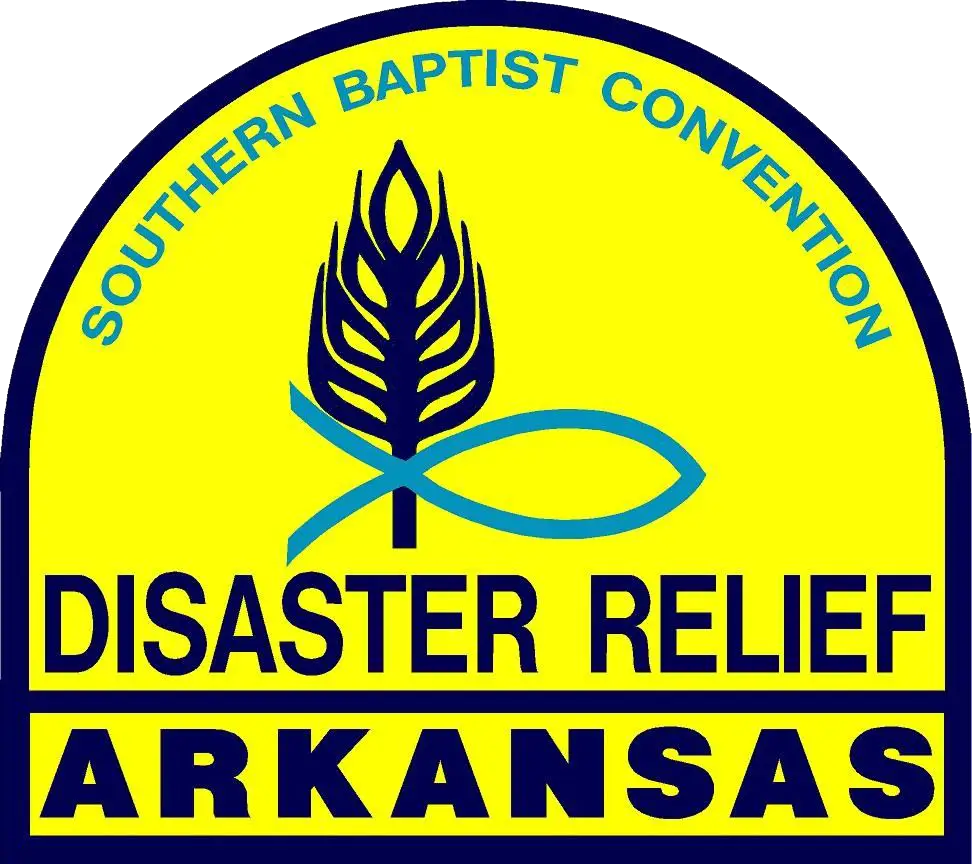What It’s Like to Be On Mission with Disaster Relief
Hard work. Long days. Family.
Being on mission with Disaster Relief is choosing to leave your comfort zone and conveniences to meet people where they are in their time of need. It’s selfless and wildly rewarding at the same time! You will work really hard, often in less than ideal environments, and crash at the end of the day with your teammates to get back up the next morning and do it again.
Disaster Relief missions are usually about a week, sometimes a bit longer or shorter. Not everyone can take off work for a week, but there is still a place in Disaster Relief for you. You might be able to serve for a long weekend or even a single day if the mission is close to home. Missions may be in Arkansas or anywhere in the United States. We even, occasionally, send teams out of the country.

So this is how a mission (deployment) develops.
- Talk of an Impending Disaster – Our Disaster Relief Director and office team discuss a plan of action in the event ABSC Disaster Relief is asked to respond. Relevant teams are placed on ALERT. Your Team Leader may contact you to prepare the unit for mission. You may have a work day to sharpen saws or pressure wash the mud from the last mission off the flood recovery equipment. This is the time to find those yellow shirts and your favorite pair of work gloves.
- Natural Disaster Strikes – The disaster hits. Chaos ensues. Locals are scrambling to see what the needs are and what can be done to help. ABSC Disaster Relief may send trained assessors at this point to determine if the response falls within our capabilities and scope of work. Contact may be made with local authorities to offer our assistance, if the need is determined. We place our relevant teams on STAND-BY. Your Team Leader may contact you to see if and when you are deployable. If you plan to make this mission, you pack your bag and make arrangements to potentially be gone for the specified time.
- A Request for Assistance is Made – We are asked to help out, and the needs fit within our capabilities and scope of work. The Disaster Relief Director decides we will be involved in the response and what our response will be. Our Disaster Relief office contacts needed Team Leaders, who then contact their teams. Contacted Team Leaders let the ABSC Disaster Relief office know when they are available to serve. Plans are made. Logistics of travel, lodging, and support functions are put into place. If your team is deploying and you are joining them on the mission, your Team Leader tells you when and where to meet for departure. Trucks are fueled. Prepared response trailers are hitched.
- It’s Go Time! – Teams are sent out on mission. We are ACTIVE. If an Incident Management Team will respond, they may be the first on site. These trained IMT members set the stage for the work to take place, making necessary connections and arrangements before the dirty work begins. Sometimes the chainsaws are needed even before the IMT is up and running. In that case, the Disaster Relief Director will bring in the chainsaw teams to begin the initial stage of response. Depending on the size of our response, feeding teams may prepare hot meals for the public and/or our volunteers. Shower/Laundry teams may set up with the IMT to provide a chance for hard-working volunteers to clean up after a long day of service. It takes a little bit to get the response up and running to full capacity. Along the way, we monitor and adjust to best meet the needs of the affected community within our capabilities and scope of work. At peak response, we may have multiple teams of multiple disciplines serving from the same home base. In a very large response, we may have multiple sites of response with a coordinating Incident Management Team. A response may last as little as a day or as long as months on end. In a lengthy response, teams will rotate in and out and, sometimes, back again. While responding with your team, you will spend your days serving a community with your trained skills. Every person contributes. All work hard. People will thank you from the bottom of their hearts for coming to them when life was really hard. You make friends with your team. You work together, eat together, and rest together. It’s your DR family.
- Our Response Is Complete – ABSC Disaster Relief has wrapped up our response to the disaster and all teams have been told to STAND DOWN. Everyone heads home for some much needed R&R. Bags are unpacked. Trailers are unhitched and parked. Even though you are thrilled to be home with your family and friends, you may really miss your teammates. You may feel an overwhelming thankfulness for all your blessings after witnessing first-hand the trauma people just like you are enduring. You pray often for the people living under duress and strain. After a few days or weeks, your Team Leader may give you a call to help get the trailer back in mission readiness. You tell your Team Leader to keep you on the short list. You can’t wait to go the next time!!!! You are hooked! You are a Disaster Relief Volunteer!
Join Us
Volunteer Today
So you want to make a difference in the lives of disaster survivors? We need you on our team!
